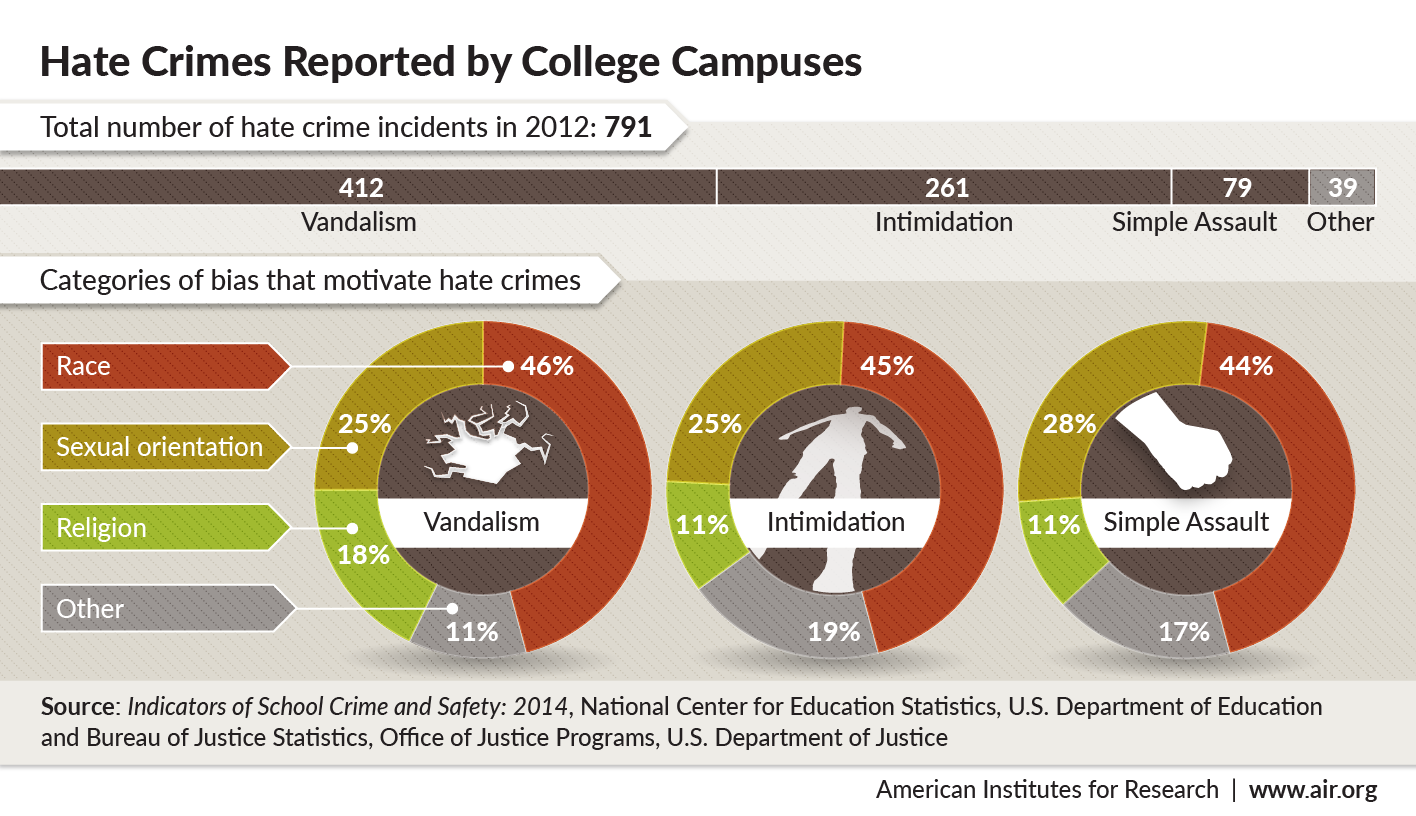New Report Co-Written by AIR Sheds Light on Campus Hate Crimes, School Safety
Washington, D.C. – The annual Indicators of School Crime and Safety report, co-produced by the American Institutes for Research (AIR), was released today by the National Center for Education Statistics (NCES) and the Bureau of Justice Statistics (BJS). The report presents the most current data on crime and safety at schools and on college campuses from the perspectives of students, teachers, principals and postsecondary institutions.
AIR experts were involved in all aspects of the publication, including statistical analysis, writing of key findings, report design, and quality control review. AIR has co-written the Indicators of School Crime and Safety reports since 1999.
This year’s report includes a new section on college hate crimes, many of them involving race or sexual orientation. In 2012, there were 791 cases. The most common hate crimes reported by postsecondary institutions were destruction, damage and vandalism (412 incidents); intimidation (261 incidents); and simple assault (79 incidents).

The report also covers student and teacher victimization; bullying and cyber-bullying; drugs and alcohol use; gun access; school security measures; security staff presence; student perceptions of personal safety at school; and criminal incidents at postsecondary institutions. Where available, data on crimes that occur outside of school grounds are offered as a point of comparison.
This year’s report shows that:
- The number of reported forcible sex crimes on college campuses increased by 77 percent between 2001 and 2012. Between 2011 and 2012, the increase was 15 percent.
- Between 2001 and 2012, arrests for drug law violations at public and private 2-year and 4-year postsecondary institutions increased by 76 percent and arrests for liquor law violations at these institutions rose by 8 percent.
- Between 1992 and 2013, the total victimization rate against students ages 12–18 at school declined from 181 victimizations per 1,000 students to 55 victimizations per 1,000 students. In 2013, students ages 12–18 were victims of about 1,420,900 nonfatal victimizations at school, including 454,900 thefts and 966,000 violent victimizations.
- In 2013, about 22 percent of students ages 12–18 reported being bullied at school, and 7 percent reported being cyber-bullied during the school year. The percentage of students who reported being bullied at school was lower in 2013 than in every prior survey year (28 percent each in 2005, 2009, and 2011 and 32 percent in 2007).
- In 2013, about 33 percent of students who reported being bullied at school indicated that they were bullied at least once or twice a month during the school year, and about 27 percent of students who reported being cyber-bullied indicated that they were cyber-bullied at least once or twice a month during the school year.
- The percentage of students in grades 9–12 who reported carrying a weapon on school property in the last 30 days decreased from 12 percent in 1993 to 5 percent in 2013. During the same period, the percentage of students who reported being in a physical fight on school property in the last 12 months decreased from 16 percent to 8 percent.
- In 2013, about 90 percent of students ages 12–18 reported the presence of school staff (other than security guards or assigned police officers) or other adults supervising the hallway at their schools. Seventy-seven percent reported the presence of one or more security cameras to monitor the school, and 76 percent reported locked entrance or exit doors during the day.
The full report is available online at https://nces.ed.gov/pubsearch/pubsinfo.asp?pubid=2015072.
About AIR
Established in 1946, with headquarters in Washington, D.C., the American Institutes for Research (AIR) is a nonpartisan, not-for-profit organization that conducts behavioral and social science research and delivers technical assistance both domestically and internationally in the areas of health, education, and workforce productivity. For more information, visit www.air.org.
###